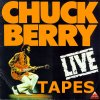
Anthony Chanu asked me:
Did you notice that the live version of Roll Over Beethoven on the first HIP-O-Select set is different from the version used on the early Radiola album?
No, I didn't. But it reminded me that I always wanted to write something about this recording and its releases. Time to do so.
Live recordings of early performances of the 1950's Rock'n'Rollers are extremely rare. Even though the artists played hundreds of gig each year, no audience tapes or concert recordings were made. In contrast to the 1970s and onwards, where visitors recorded and saved almost every concert, in the 1950s there was no portable personal audio recording equipment available. Even record companies had no intention to tape the raw public performance instead of using a clean and controlled studio environment. Too much effort, too bad quality.
Due to this, the only surviving performance recordings from the 1950s stem from radio and TV broadcast as well as from movies. Movies and TV broadcast however usually had the artists lip-syncing to a playback of their hit records meaning these are not live performances even if some audience is heard.
The only surviving true live performances by Chuck Berry recorded in the 1950s are from the Newport Jazz Festival in 1958 and from New York, 1956. The Newport recordings were made because some of it was used for the movie "Jazz on a Summer's Day". The story behind the New York recordings is even more interesting:
Between March 24 and September 25, 1956, Alan Freed hosted a series of 26 shows on CBS radio. Each show ran half an hour and was called “The Camel Rock'n'Roll Dance Party”. Most of the shows were recorded in New York and produced by WCBS, CBS' New York radio station. The shows from May to mid-June were recorded in Hollywood and produced by KCBS instead because Alan Freed was filming in Hollywood then.
Chuck Berry, who was in New York for filming his segment of Alan Freed's "Rock, Rock, Rock" movie, contributed to the twenty-second show which was broadcast on Tuesday, August 28, 1956. Along with him were The Flamingos and Frankie Lymon & The Teenagers. It is not clear when and where the show was recorded. It may have been broadcast “live” as most other 1950s radio shows were. Since there is a loud audience to be heard, the venue must have been a smaller theater. Most likely it was CBS-TV Studio 50, now the Ed Sullivan Theater, on Broadway or the theater in CBS' Studio Building at 52nd Street.
Many of the original tapes from the Camel Rock'n'Roll Dance Party as used for broadcast have been made available to the public in 2015. You can listen to them at
archive.org.
In addition the AFRTS (United States Armed Forces Radio and Television Service) created transcription records from the broadcasts. These transcription records were then sent out to AFN radio stations worldwide for broadcast to US military in foreign countries. (This image shows a sample AFRTS record label. If you have a label scan of this or any other Rock'n'Roll Dance Party transcription, please email it to the address given under Copyright to the right.)
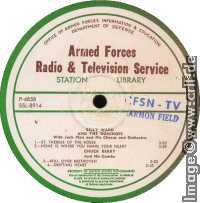
The AFRTS transcriptions were edited over the original broadcast. Most importantly all the advertising spots and the name of the show sponsor "Camel Cigarettes" were removed from the recording. This cut off almost five minutes from each show. In addition AFRTS added a different out cue to the show. The transcription records containing the edited shows were produced in small quantities for the AFN stations abroad. A few of them survived until the 1970s, even though their unusual format of 16-inch diameter required special turntables to play.
The AFRTS versions of most of the shows are available from the
Old Time Radio Catalog as Audio-CDs.
Snippets of these shows taken from the AFRTS disks have found their way to commercial albums and CDs since the 1970s. The first record I know of was Radiola's
Rock'n'Roll Radio (Radiola MR-1087) published in 1978. Roughly at the same time a series of five albums called
Alan Freed's Rock n' Roll Dance Party (WINS 1010-1014) came out with the same and additional segments from the AFRTS records. The Flamingos' performance of the August 28 show was to be found only on the WINS release, while both Berry and the Teenagers were on both. A CD release containing 27 tracks was published by Magnum Force in 1991 as
Rock And Roll Dance Party (Magnum Force CDMF 075).
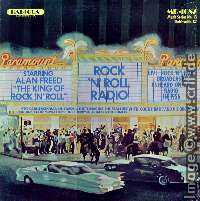
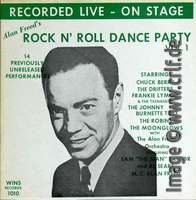
The August 28 show starts with Bern Bennett announcing Alan Freed. Freed then opens the show and introduces his house band led by Sam "The Man" Taylor which start a four-minute instrumental called
Pretzel. Next follows a lengthy Camel spot introduced by Freed as "the Camel song". After the advertisement The Flamingos sing
A Kiss From Your Lips and, as Freed proudly declares, their upcoming next release
The Vow. After this another Camel spot explains in detail while one has to smoke only the sponsor's cigarettes.
"And now back to our Camel Rock And Roll Dance Party. And here's the guy that is just the greatest: Chuck Berry and
Maybellene!" In less than two minutes Berry runs really fast through his first record. Of the band only the drummer is heard with a short solo. "Wow!" sighs Freed and directly announces the next number: "Chuck Berry and his current bagel, right back to our Camel mike with
Roll Over Beethoven!" Again we hear mostly Berry playing both lead and rhythm on his guitar. During the mid-song solo, the crowd hollers and shouts "Go! Go! Go!" indicating that we probably miss seeing Berry duck-walking across the stage. At the very end of the song, one of the sax players cannot step back any longer and adds some answering licks. With "Chuck Berry, just fabulous!" Freed ends Berry's performance.
And the show returns to promoting Camel cigarettes. After that Frankie Lymon & the Teenagers perform
I Promise To Remember and
Why Do Fools Fall In Love followed by another spot featuring the Camel song. The show ends with Sam Taylor and the Big Band going crazy on another instrumental called
Look Out! Alan Freed once again praises Camel and finishes the show.
As said, the AFRTS edits of the show exclude all the Camel spots as well as all mentions of the sponsor in Freed's announcements. So here it goes "right back to our (cut) mike with
Roll Over Beethoven."
Maybellene is about 2:00 minutes long and Roll Over Beethoven clocks at 3:10 approximately.
But on HIP-O Select's release of the 4-CD set
Johnny B. Goode - His Complete '50s Chess Recordings (HIP-O-Select B0009473-02, 2008) this song only runs for 2:44 minutes. And if you listen closely, you will notice that after the solo almost a complete verse is missing and replaced with a segment from the beginning of the show. Why?
I asked Fred Rothwell who helped compiling the CD sets. He told me that Andy McKaie of Universal Music had found one tape in the MCA archives containing both the two 1956 live songs and eight unusual Chess studio recordings with artificial audience dubbed. Even though the live songs we not Chess recordings they decided to include them on the set. And this edited version is as it was on the tape.
At that time no-one noticed that this was a damaged or repaired track. Fred said that he later became aware of this and when he compiled the recordings for the Bear Family boxset
Rock And Roll Music - Any Old Way You Choose It (Bear Family BCD 17273 PL, 2014) the correct and complete track from the AFRTS transcription record was used.
Eight unusual Chess studio tracks with audience dubs and the two Camel show tracks on one tape? This made me remember one of the stranger LP albums I have in my collection:
Alive And Rockin' (Stack-O-Hits Records AG9019, 1981).
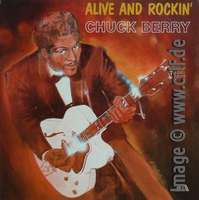
This album had the two 1956 live tracks plus eight rarities which at that time were otherwise only known from the
American Hottest Wax bootleg (Reelin' 001): previously unreleased versions of
Rock And Roll Music,
21 (here called
Vacation Time),
Reelin' And Rockin',
Sweet Little Sixteen, and
Childhood Sweetheart along with the undubbed version of
How High The Moon plus the previously unknown songs
I've Changed (here called just
Changed) and
One O'Clock Jump (here as
Chuck's Jam). All eight tracks were "enhanced" with fake audience on the Stack-O-Hits release. Yes:
How High The Moon which was released in 1963 with audience noise and finally came to light in its original form on the Reelin' bootleg, was re-destroyed with different audience noise.
Fred confirmed that these are exactly the eight tracks from the mysterious tape in Universal's archive. And yes, the album also contains the edit of the Camel show live recording of
Roll Over Beethoven. So this is not new, we only never recognized it.
Does this mean that Chess had created another fake live album and released it on the Stack-O-Hits label? Certainly not. In 1981 the Chess archives were owned by All Platinum Records and all they did with it was a hit sampler called
The Great Twenty-Eight.
So who was Stack-O-Hits Records? Probably no-one at all. Stack-O-Hits was one of a dozen names used by a company called "Album Globe Distribution" (hence the AG catalog number). A.G. was known "notorious for its quasi-legitimate and downright illegal releases. Every record they issued used a different label name, but all have an AG prefix followed by a 4-digit number". (quote from
discogs.com)
While the album's liner notes praise Berry to have "directly and primarily influenced artists from The Beatles, Bob Dylan, The Rolling Stones, Rod Steward, to Bob Seger, Led Zeppelin and so many more", they completely lie about the origins of the recordings contained:
Stack-O-Hits is pleased to be able to bring you this fantastic live performance by Chuck Berry, recorded in his prime, performing not only a selection of his biggest hits, but a taste of gut bucket Chicago Blues and high-flyin' jazz as well. Don't let this get by -collectors take note- these performances are released for the first time here on Stack-O-Hits Records.
The only "first time" here was that we didn't knew the modified recordings before. The eight studio tracks were stolen from the Reelin' bootleg and edited to sound "live". The two true live recordings were taken from the Radiola or WINS release. Or more probably they might stem from a broken tape copy of the AFRTS transcription record as this would explain why
Roll Over Beethoven was edited (repaired?).
How the master tape of
Alive And Rockin' came into the MCA archives for Andy McKaie to find it there, stays a mystery. Does anybody know whether other Album Globe bootlegs were re-released by MCA or Universal?
Thanks to Fred Rothwell for help with this article!
